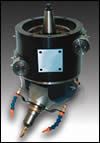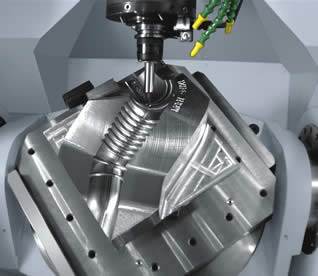Five-Axis Machining: What Are The Benefits and How Can You Achieve this Capability?
The alternative you choose to achieve five-axis machining benefits will be application driven and can have a significant effect on your bottom line.
The technology and equipment for performing multi-axis machining has been around for a long time. The methods used to achieve simultaneous five-axis in such industries as aerospace, energy production, oil and gas, medical, woodworking and mold-making are similar, yet each industry has specific applications and needs that determine how a given manufacturer gets the job done.
In both vertical and horizontal milling, two additional axes are added to the existing X, Y and Z axes. These two axes are typically a rotary axis that rotates around the Z axis and a tilting axis that rotates around the Y or Z axes.
There are currently three main ways of achieving simultaneous five-axis milling: (1) a dedicated five-axis machining center; (2) a tilting/rotary or trunnion table; and, (3) a spindle head attachment.
Dedicated Five-Axis Machining Center
There are currently more than 15 original equipment manufacturers of five-axis machining centers sold in the U.S. The majority of these machining centers are large, powerful, accurate and expensive with prices ranging from $500,000 to more than $1,500,000. The least expensive five-axis machining centers on the market today have a starting price of about $250,000.
The chief drawback of the dedicated five-axis machines is their range of motion, which is generally limited to (+/- 30 degrees). Workpieces that require a steeper angle of cut must be manually repositioned and restarted. Also, these machines are somewhat less rigid than a three-axis machine of the same size and class.
In recent years, many companies have begun offering a dedicated five-axis machining center that is simply a tilting rotary table that is integrated into the table of the mill. Oftentimes, there is a rotary table only, and the spindle offers the tilting capacity. Despite the limitations on part size and weight, these hybrid machines are also very expensive.
Tilt-Rotary Tables
Several manufacturers now produce a tilting-rotary table that can be mounted to the bed of a (three-axis) CNC machine. Simple rotary tables have been available for many years and are used extensively by small and large machine shops around the world to index parts for various machining operations.
A tilting-rotary table can rotate and tilt a part at various angles to provide machine access to many sides of the part, resulting in true five-axis machining.
The relatively small work surface of a tilting-rotary table places significant limits on the type of the workpiece that can be mounted to it including limits of length, width, height and weight. Additionally, tilting-rotary tables are themselves very large and use much of the host machine’s working envelope. Even the largest tilt-rotary tables can reduce the working envelope of the host machine by 75 percent or more.
Tilt-rotary tables are not suitable to hold parts during heavy cutting operations, and parts over 12 inches can begin to impinge on the surrounding surfaces. Although the tilting rotary table is an attractive solution for machining smaller parts, today’s customers require flexibility and a wide range of capabilities. If this is the only five-axis alternative available, a shop will have to turn down jobs that exceed their size and weight restrictions.
Spindle Head Attachments
The primary advantage of a spindle head attachment is that it can access all points of the machining center’s work envelope. The head places no limit on the size of the workpiece that can be machined.
Today, there are a few American, Italian and German companies that manufacture and sell a programmable spindle head for attachment to large three-axis milling machines. When properly installed, these heads are fairly dependable, accurate and expensive. Because of their size and weight they cannot be mounted onto any of the small to mid-sized machining centers and are reserved for only the largest gantry type milling machines. Installation is permanent and requires custom fabrication and fitting. The price range for these head attachments is $175,000 to $300,000 plus the cost of custom fabrication and installation.
One exception to the currently available spindle attachments is one that is fully programmable and can be used to convert nearly any three-axis CNC machine to a true, simultaneous five-axis machining center.1 By adding a tilt capability of +/- 90 degrees and a continuous 360-degree rotary motion, it can access all points of the machining center’s work envelope.
Because this unique head is portable and can be mounted in less than 30 minutes, it allows the owner to benefit from the accuracy and rigidity of the three-axis mill for significant metal removal then mount the attachment to complete five-axis profiling, holes, pockets, etc. The cost is similar to that of the larger tilt-rotary tables.
The Benefits of Machining with Five Axes
With careful consideration given to the specific application and the various alternate means of achieving five-axis capabilities, there are a large number of benefits that five-axis machining can bring to the moldmaker.
By using a flat bottom end mill and maintaining perpendicularity to the complex surface, machining time can be greatly reduced. This is accomplished by stepping over the full diameter of the cutter, which reduces the required number of passes across a surface. The same principle applies to side milling of angled surfaces. This same process will also eliminate ribbing caused by ball-nose end mills, resulting in a much better surface finish, and cut down on manual millwork and handwork required to clean up kellered surfaces.
Five-axis technology also eliminates multiple setups required to re-position the workpiece at complex angles. This not only saves time, but greatly reduces errors and costly tooling and fixture expenses required to hold the workpiece in place. It also provides the ability to machine complex parts that are not otherwise possible—including holes, pockets and tapping required to be normal to a complex surface.
Through the use of shorter tools, five-axis milling can complete an entire part without re-fixturing or using the long tools required in a similar three-axis application and still deliver the final product in less time and with a better surface finish. Because the cutter extends out from the pivot point, a spindle-based attachment can actually mill outside the host machine’s stated travels when working inside a mold cavity.
1 Tri-Tech Precision Products, Inc. M5414 spindle attachment.
Related Content
Control Helps Push the Limits of Five-Axis Micro Mold Machining Accuracy
Toolmaker quickly meets the demands of critical medical device manufacturers with a new five-axis machine tool equipped with the right control technology.
Read MoreDevelopments in High-Speed Machining Technology
There have been many exciting developments in high-speed machining relative to machining centers and controls, tooling and CAD/CAM systems.
Read MoreDesign Strategy Tackles Big and Small Complexity Challenges for Southeastern Mold Builder
Delta Mold Inc.’s core values, engineering expertise, five-axis machines and molding capabilities help the team turn a proposal into a manufactured mold or part with custom design, finishing and assembly.
Read MoreRead Next
Improve Shop Competitiveness With Five-Axis Capability
The key to keeping work local, while still remaining profitable, is a willingness to evaluate and dramatically alter your shop’s processes by investing in new technology.
Read MoreHow to Use Strategic Planning Tools, Data to Manage the Human Side of Business
Q&A with Marion Wells, MMT EAB member and founder of Human Asset Management.
Read MoreReasons to Use Fiber Lasers for Mold Cleaning
Fiber lasers offer a simplicity, speed, control and portability, minimizing mold cleaning risks.
Read More








_300x250 1.png;maxWidth=300;quality=90)


.jpg;maxWidth=300;quality=90)


















